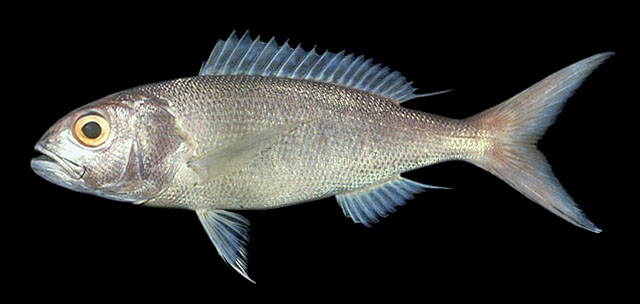| Lutjanidae (Snappers), subfamily: Etelinae |
| 100 cm TL (male/unsexed); max.weight: 8,154.0 g; max. reported age: 44 years |
|
benthopelagic; marine; depth range 40 - 400 m |
| Indo-Pacific: East Africa to Hawaii and Tahiti, north to southern Japan, south to eastern Australia and Lord Howe Island. |
|
Dorsal spines (total): 10-10; Dorsal soft rays (total): 11-11; Anal spines: 3-3; Anal soft rays: 8-8. This species is distinguished by the following characters: body elongate, laterally compressed; jaws about equal or lower jaw protruding slightly; premaxillae protrusible. maxilla extending to vertical through about anterior margin of pupil; upper and lower jaws both with an outer row of conical to small canine teeth and an inner band of villiform teeth, the caniniform teeth at anterior ends of jaws are not appreciably enlarged; teeth on vomer triangular patch, maxilla without scales or longitudinal ridges; interorbital region flattened. Gill rakers on first gill arch 7-8 + 15-18 = 22-26; last soft ray of both dorsal and anal fins well
produced, longer than next to last ray; caudal fin forked; pectoral fins long, about equal to or somewhat shorter than head length; membranes of dorsal and anal fins without scales; tubed
lateral-line scales 57-62. Colour variable, ranging from brownish to lavender or reddish
purple; snout and interorbital space with narrow yellow lines and blue spots often persisting as dark spots when preserved; dorsal and caudal fins light blue or lavender with reddish orange margins (Ref. 9821). |
| Adults occur over rocky bottoms (Ref. 30573); off Guam, caught most abundantly between 180 and 270 m (Ref. 9821). At night, they migrate vertically to the upper part of its habitat to feed (Ref. 11888). They feed on small fishes, shrimps, crabs, amphipods, ascidians and salps. Marketed fresh (Ref. 55). Caught mainly with bottom longlines and deep handlines, marketed main fresh and a good quality food fish (Ref. 9821). |
|
Least Concern (LC); Date assessed: 05 March 2015 Ref. (130435)
|
| harmless |
Source and more info: www.fishbase.org. For personal, classroom, and other internal use only. Not for publication.

